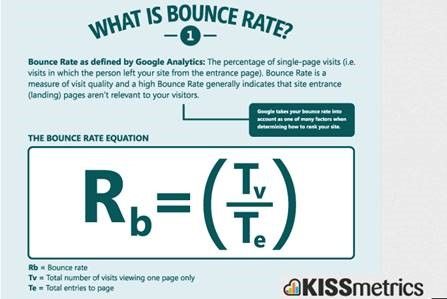What is Bounce Rate in Google Analytics

What does bounce rate mean?

Bounce Rate: Does it Matter?
When it comes to Google Analytics, there’s plenty of metrics and at a glance it can seem overly complex. But if you break it down it becomes clear what should be important to your online business. Today, we will look at bounce rate in Google Analytics and how to understand it.
Bounce rate is something that some SEO agencies tend to gloss over. Google has not explicitly stated bounce rate as a direct ranking factor, which is partly the reason for this. However, bounce rate can give a strong indication of customer need fulfilment, which is really what Google exists for and strives to deliver. Popularly, Google is said to internally use the vision statement “to provide access to the world’s information in one click.” If you actually did provide an answer to a query in one click, that page would show a high bounce rate. But you often hear that a low bounce rate is more desirable- so what is a healthy bounce rate?
Bounce Rate Definition:
A bounce in Google Analytics is:
- A single session where the visitor went to only one page.
- User did not interact further with the site (eg. make a purchase, click through to another page, fill in email address)
- As a result, Google has nothing to measure against to calculate how long was spent on the page so records a session duration of 0 seconds.
- This is shown as a percentage value. So a high bounce rate may be 86% and a low one may be 8%.
Do I want a high or low bounce rate?
The answer is *drumroll please*
It depends. Bounce rate alone can’t measure a successful interaction and must be measured in context for it to be a useful metric.
The reason bounce rate is not often used as a hard metric is because not every page is intended to send the prospect further down the sales funnel.
Below, we look at 2 scenarios where a positive interaction may give a completely different result for bounce rate.
When is a high bounce rate good?
To be seen as an industry leader and an authority in your field is incredibly valuable at the wider end of the marketing funnel. 81% of shoppers now conduct online research before buying. For a customer to make return visits for more information relating to your products from your site is a very positive thing. Who would you rather inform your prospect on your product or service- your competitor?
Example 1:
Let’s say we have a searcher called Larry. Larry wants to know what the term CFD stands for in the field of trading.
Your website, CFDtrading.co.uk, has a blog post entitled ‘What is CFD Trading?’. This blog post is titled to exactly answer the question that the prospect is searching for. It has on-page optimization directly relating to this query and is therefore shown higher in the search results, so it gets more traffic.
In this case, the post summarizes the answer so well that Larry understands from this single page exactly what CFD trading is. There is no need for him to click any further, or interact with your site- he has his answer and happily navigates away from your website- this is a positive interaction. This would be recorded in Google Analytics as a high bounce rate page, but is not negative, as everything worked perfectly as intended and the user’s query was answered.
When is a high bounce rate bad?
One example where you would want your average bounce rate to be low is for your home page. Your home page should generally entice a prospect to click through to another page. A home page is unlikely to answer the user’s query directly, and having a high bounce rate average on this page would be more likely to mean that your digital marketing strategy could use some tweaks to optimise for customer conversion.
Example 2:
Larry has now decided to open a demo forex trading account.
He searches in Google ‘open forex trading account’. The homepage for your website, CFDtrading.co.uk. comes up in the first page of results.
This time, although the page is optimised for the search term ‘open demo forex account’ the home page doesn’t really make it clear how to open an account. Maybe it’s hidden in a sub menu, or right at the bottom of the page in small print. It doesn’t stand out to Larry.
Larry has a glance at your page, can’t see how to open a demo trading account, and clicks away from your site to try a different result.
This is an example of poor user experience (UX) causing a high bounce rate and creating a negative experience for the searcher. Larry is less likely to return if he has an experience like this with your website, so in this instance to have a high bounce rate would be undesirable.
Putting bounce rates in context:
As you can see, a high bounce rate is not always a bad thing. There are many other metrics that we consider here at WMG to ensure a full picture is painted. By doing things like measuring average time spent on page and pages per session, we can build a more complete picture of how engaging the important pages of your site are.
If you want to learn more, contact us today!